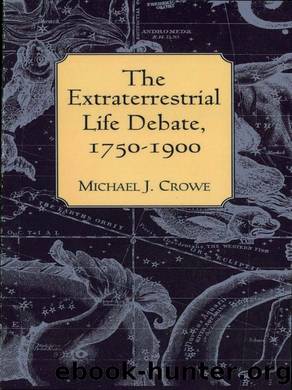The Extraterrestrial Life Debate, 1750-1900 by Michael J. Crowe

Author:Michael J. Crowe [Crowe, Michael J.]
Language: eng
Format: epub
Tags: Science, History, Space Science, Astronomy
ISBN: 9780486145013
Google: wUnCAgAAQBAJ
Publisher: Courier Corporation
Published: 2012-05-04T01:08:41+00:00
PART III
From 1860 to 1900
8
New approaches to an ancient question
1. Developments from the 1860s, especially the ânew astronomyâ
Writing in 1867 in what may have been the last review of Whewellâs Of the Plurality of Worlds: An Essay, Rev. Theodor Appel (1823â1907), an American professor of astronomy and mathematics, described it as âlike a bomb-shell thrown into an army resting on its victorious march.â1 Although Appelâs comment is basically correct, it should not obscure the fact that some publications in the years after Whewellâs Essay show no awareness even of its existence, let alone its arguments.2 Moreover, a significant number of the pluralist articles from the 1860s were centered on issues dominant in the 1850s.3 The slowness with which ideas change is dramatically indicated by the fact that life on the sun was championed in the late 1850s and in the 1860s by a number of American, Belgian, British, French, and German authors. Some supporters of solarians came from the fringes of science,4 but in other cases, prominent scientists advocated this idea. For example, the English chemist Dr. Thomas Lamb Phipson (1833â1908) asserted in 1867 that the sun âmust indeed be a region of eternal life and perfect happiness.â5 The next year the English astrophysicist J. Norman Lockyer (1836â1920), in his Elements of Astronomy, presented solar life as a possibility.6 Also in the 1860s, Mungo Ponton (1802â80), a pioneer of photography and a founder of the Bank of Scotland, attacked Whewellâs ânotorious bookâ and championed both William Herschelâs theory of a cool, habitable core for the sun and John Herschelâs view that Nasmythâs âwillow leavesâ consist of giant organisms. 7 In an 1859 address to the Belgian Academy, Jean Baptiste Joseph Liagre (1815â91), an astronomer and mathematician, concluded his discussion of the sun by stating that it ought no longer be seen âas a devouring furnace and destroyer, but as the most imposing of the planetary globes; [as a] majestic abode where the perfection of organized beings ought to be . . . in harmony with the magnificence of the habitation.â 8 Most energetic on behalf of solarians was Fernand Coyteux (1800â?), who in 1866 published a massive book arguing for life on the sun, thereby creating a controversy in a learned society in Poitiers, France.9
New approaches, however, did arise, the most important being associated with what came to be called the ânew astronomy.â Central in this development was Sir William Huggins (1824â1910), an English astronomer, who in an 1897 paper surveyed his more than three decades of discoveries as one of its leading practitioners.10 There Huggins recounts his dissatisfaction during the 1850s with the âroutine character of ordinary astronomical workâ and his hope of finding new methods of research. This wish was fulfilled when he learned of the publications dating from 1859 of Bunsen and Kirchhoff, who showed that a prism or diffraction grating added to a telescope transformed it into a new instrument, the spectroscope, which in turn made the astronomer an astrophysicist and astrochemist. Kirchhoffâs 1861 spectroscopic determination
Download
This site does not store any files on its server. We only index and link to content provided by other sites. Please contact the content providers to delete copyright contents if any and email us, we'll remove relevant links or contents immediately.
| Aeronautics & Astronautics | Astronomy |
| Astrophysics & Space Science | Comets, Meteors & Asteroids |
| Cosmology | Mars |
| Solar System | Star-Gazing |
| Telescopes | UFOs |
Tools of Titans by Timothy Ferriss(8218)
Turbulence by E. J. Noyes(7936)
Secrets of Antigravity Propulsion: Tesla, UFOs, and Classified Aerospace Technology by Ph.D. Paul A. Laviolette(5309)
Astrophysics for People in a Hurry by Neil DeGrasse Tyson(5132)
Room 212 by Kate Stewart(5037)
Design of Trajectory Optimization Approach for Space Maneuver Vehicle Skip Entry Problems by Runqi Chai & Al Savvaris & Antonios Tsourdos & Senchun Chai(5011)
Pale Blue Dot by Carl Sagan(4912)
The David Icke Guide to the Global Conspiracy (and how to end it) by David Icke(4625)
A Journey Through Divination and Astronomy by Publishing Pottermore(4344)
Goodbye Paradise(3727)
Apollo 8 by Jeffrey Kluger(3637)
COSMOS by Carl Sagan(3554)
Losing the Nobel Prize by Brian Keating(3498)
The Five People You Meet in Heaven by Mitch Albom(3475)
How to Read Water: Clues and Patterns from Puddles to the Sea (Natural Navigation) by Tristan Gooley(3406)
Brief Answers to the Big Questions by Stephen Hawking(3369)
How to Read Nature by Tristan Gooley(3249)
The Order of Time by Carlo Rovelli(3145)
A Brief History of Time by Stephen Hawking(2960)
